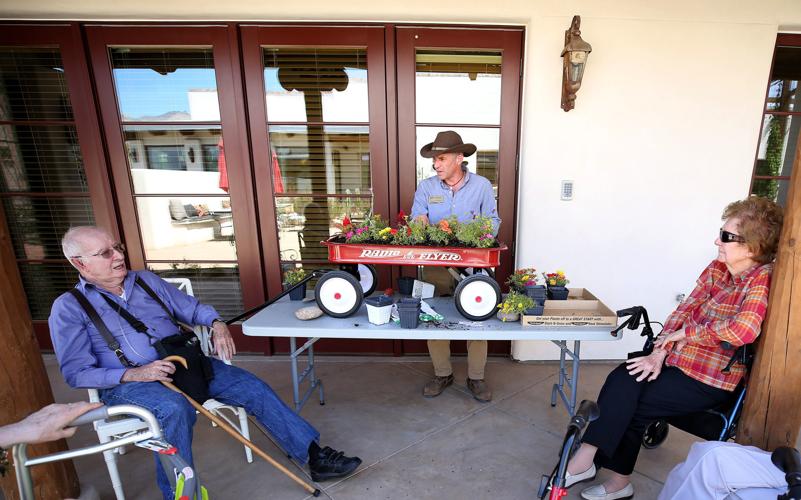Researcher Roger Ulrich reported in 1984 that hospital patients with an outdoor view of trees healed faster and used fewer pain meds than those without that view.
Since the 1980s, a natural healing technique out of Japan called forest bathing ã essentially spending time in nature to reduce stress ã has become increasingly popular.
For decades studies have shown the healing powers of plants and nature, says Esther Sternberg, director of the University of ûÜÒøøÝýË Institute on Place and Wellbeing.
ãThe part of the brain that processes beautiful views happens to be rich in endorphins,ã says Sternberg, who also is research director of the ûÜÒøøÝýË Center for Integrative Medicine and has written extensively on this subject.
ãIt just makes sense that it makes you feel good.ã
People are also reading…
Now a newly opened assisted living senior community is putting the research into practice.
A 2,500-square-foot plot of landscape and edible plants sits in the middle of The Hacienda at the River, 2720 E. River Road, a 71-unit community for seniors who need help with daily-living tasks or memory care.
The garden has cacti and succulents to provide visual interest, but itãs mostly used for edibles. For the season that includes several tomato varieties, tomatillo, green onion, strawberry, celery, thyme, rosemary and tarragon. Trees yield kumquats, limes, pears and figs in season.
Theyãre harvested for use in the communityãs kitchen.
Wide paths meander through the garden, which is surrounded by living quarters. Benches, a fountain and a cafûˋ table with chairs invite residents and visitors to stay, relax and contemplate.
A 25-foot-high open structure encourages plants to grow up its walls and posts. That greenery will eventually surround the garden. The plan is to give people the feeling of being enveloped in nature.
ãThe idea ãÎ is that you are transformed in this healing space. I want you to feel like youãre going into it,ã says David Freshwater, chairman and developer for Watermark Retirement Communities. The ûÜÒøøÝýË-based company opened The Hacienda at the River last summer.
The garden and related wellness activities are the first of their kind within Watermarkãs more than 50 communities nationwide. Freshwater speaks of it as a demonstration of future assisted-living developments that includes wellness activities like horticultural and equine therapy, tai chi and meditation.
ãPeople are not asking for this,ã he admits, ãbut we think itãs important and weãre going to be studying this stuff with the (UA) and be able to disseminate this to the industry.
ãWe feel strongly that it was the right vision to take.ã
Resident Paul Barby, for one, is sold on the garden as an important amenity.
ãOne of the attractions that drew me to Hacienda was this meditation garden,ã says the 82-year-old. ãI did a lot of gardening and I always loved plants. This is very much a plus.ã
Barby joined three fellow residents on a recent warm afternoon to garden with Jason Welborn, the communityãs horticultural guide.
That dayãs ãIn the Healing Gardenã session was going to include planting vegetables in the raised bed.
But the 90-degree afternoon would make the residents feel uncomfortable. So Welborn, who previously managed the heritage orchard at Tumacacori National Historical Park, decided to instead have them plant lavender, yellow Dahlberg daises, blood-red celosia and red and orange portulaca into a dirt-filled red wagon for an upcoming charity auction.
First-time gardener Luanne Maxon-Provencher, 80, dove right in. She was joined a little later by Lois Struthers, 89, who used to garden, and Virginia Reynolds, 99. Barby added finishing touches.
Ignoring the garden gloves and trowels, the residents used bare hands to pull plants out of containers, put them in holes that Welborn dug and pat the roots into the soil.
At one point they laughingly compared how dirty their hands got.
During several breaks in the one-hour session, the group asked Welborn how to take care of plants in their units and spoke about birds.
They all praised the garden program. ãI had a lot of flowersã that Struthers had to give up because keeping up a garden was too hard, she says. Looking toward the plant-filled wagon, she adds, ãThis is wonderful to get back to.ã
ãOne thing I donãt want to do is garden,ã declares Reynolds. She quickly adds, ãI love to do it with friends. I just donãt want to do it alone. I like the company.ã
Welborn sees benefits over and over among gardening residents ã spending time with others, feeling pride in what theyãve accomplished and getting light exercise.
He finds that residents with memory loss remember and share life stories when prompted by gardening activities or plants from their past.
He recalls guiding a memory-care residentãs hand to dig a hole, hold a plant and put it in the ground. She didnãt know why she was doing this, he says, but that wasnãt what mattered in the moment.
ãThe tactile contact with soil and plants is really beneficial,ã he explains. Soil has chemical properties that are soothing.
Sternberg, who is not involved in the Hacienda garden or program, echoes that thought. Plant scents, color and texture can conjure calmer times, especially for people with memory loss.
ãOne of the big problems they have is anxiety,ã she says. ãAs they get used to going into this garden, it becomes more familiar and they have less anxiety.ã
ãThey may not remember why they feel good,ã she says, ãbut (gardens) bring back positive emotions from an earlier time.ã






